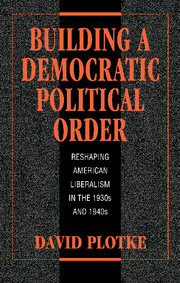Book contents
- Frontmatter
- Contents
- Preface
- Introduction: The Democratic order as a political project
- 1 When does politics change?
- 2 Creating political orders: the logic of the Democratic experience
- 3 Democratic opportunities in the crises of the 1930s
- 4 Passing the Wagner Act and building a new Democratic state
- 5 Party and movements in the Democratic upsurge, 1935–7
- 6 Progressive liberalism as pragmatic common sense
- 7 Surprising years: electing Truman and sustaining the Democratic order, 1947–9
- 8 Passing Taft-Hartley: what the losers won (and what the winners lost)
- 9 New political fronts? growth and civil rights in the 1940s
- 10 Democratic anti-Communism and the Cold War
- 11 From Truman to Kennedy: the reach and limits of Democratic power
- 12 Was the Democratic order democratic?
- Index
4 - Passing the Wagner Act and building a new Democratic state
Published online by Cambridge University Press: 17 September 2009
- Frontmatter
- Contents
- Preface
- Introduction: The Democratic order as a political project
- 1 When does politics change?
- 2 Creating political orders: the logic of the Democratic experience
- 3 Democratic opportunities in the crises of the 1930s
- 4 Passing the Wagner Act and building a new Democratic state
- 5 Party and movements in the Democratic upsurge, 1935–7
- 6 Progressive liberalism as pragmatic common sense
- 7 Surprising years: electing Truman and sustaining the Democratic order, 1947–9
- 8 Passing Taft-Hartley: what the losers won (and what the winners lost)
- 9 New political fronts? growth and civil rights in the 1940s
- 10 Democratic anti-Communism and the Cold War
- 11 From Truman to Kennedy: the reach and limits of Democratic power
- 12 Was the Democratic order democratic?
- Index
Summary
In 1934, I went to work for TVA as a secretary in the filing department. They didn't mind that I was blacklisted. TVA was very liberal and prounion at that time, and they had an office workers' union – the American Federation of Office Employees, which I joined – so they were used to dealing with unions. All the time I worked for TVA, I stayed active in the labor movement as a delegate to the Central Labor Council and a volunteer organizer through their general organization committee.
On Labor Day of 1936 we put on the biggest and longest parade this part of the country had ever seen. We marched down Gay Street (our main street) to the tune of five high school bands. Every local union, under the banner of the AFL, had a big float. … We had a beauty queen, a wrestling match, and free barbecue – all the hoopla that goes with a celebration.
– Lucille Thornburgh, a union activist in TennesseeWho passed the Wagner Act?
The Wagner Act (National Labor Relations Act, or NLRA) passed in 1935 amid economic and political crises. Its passage was due primarily to the efforts of progressive liberals inside and outside the government, allied with a mass labor movement.
- Type
- Chapter
- Information
- Building a Democratic Political OrderReshaping American Liberalism in the 1930s and 1940s, pp. 92 - 127Publisher: Cambridge University PressPrint publication year: 1996



